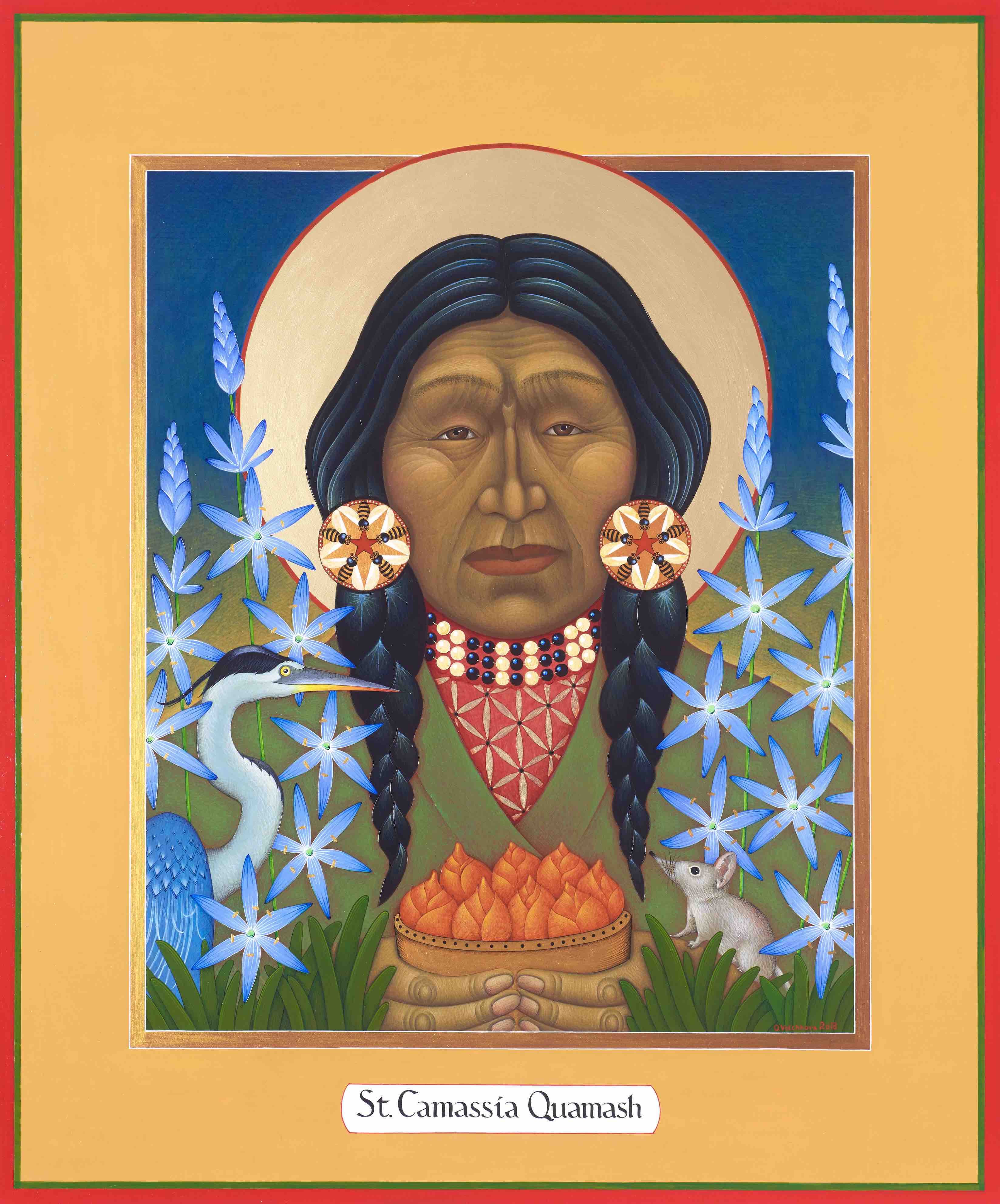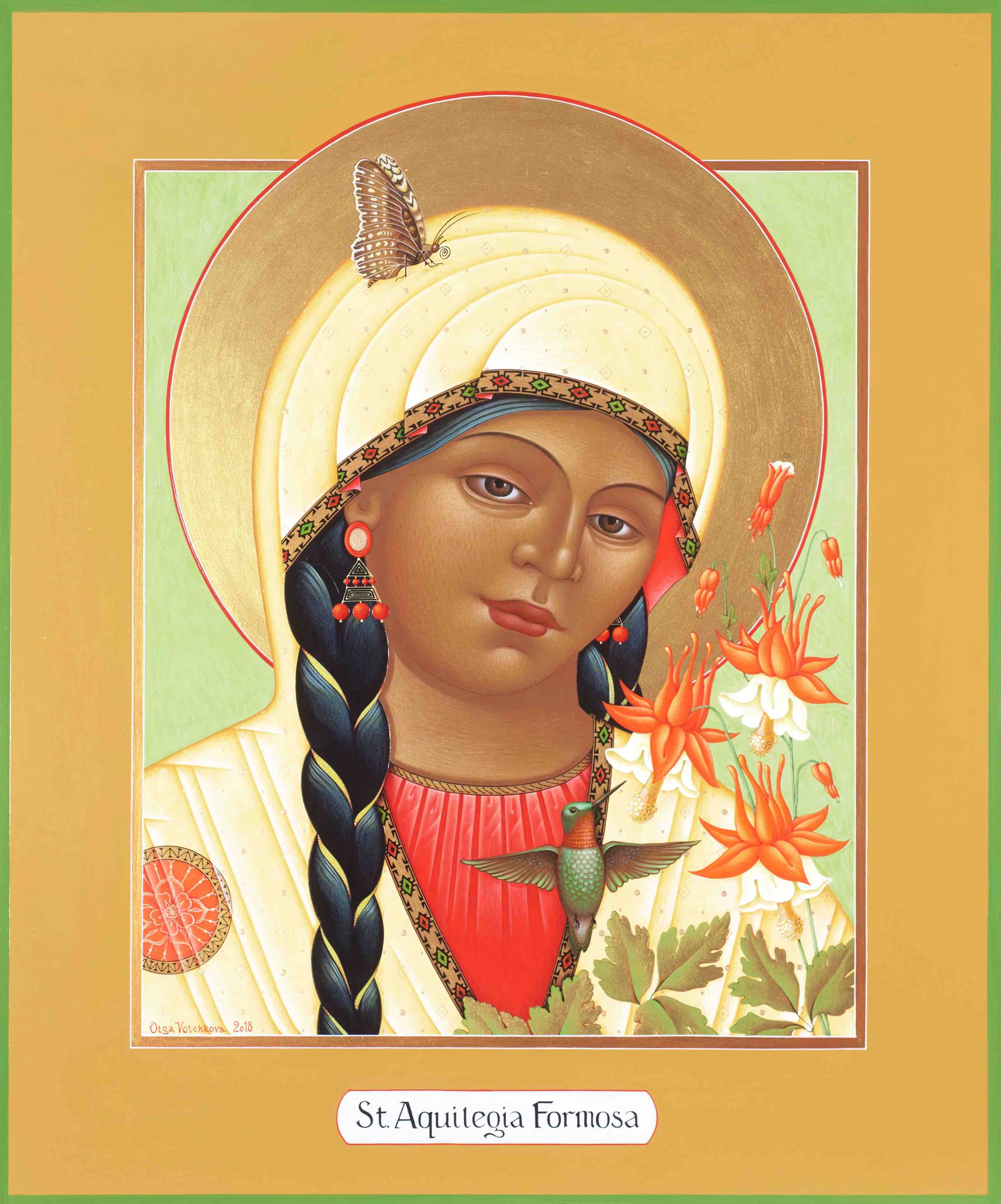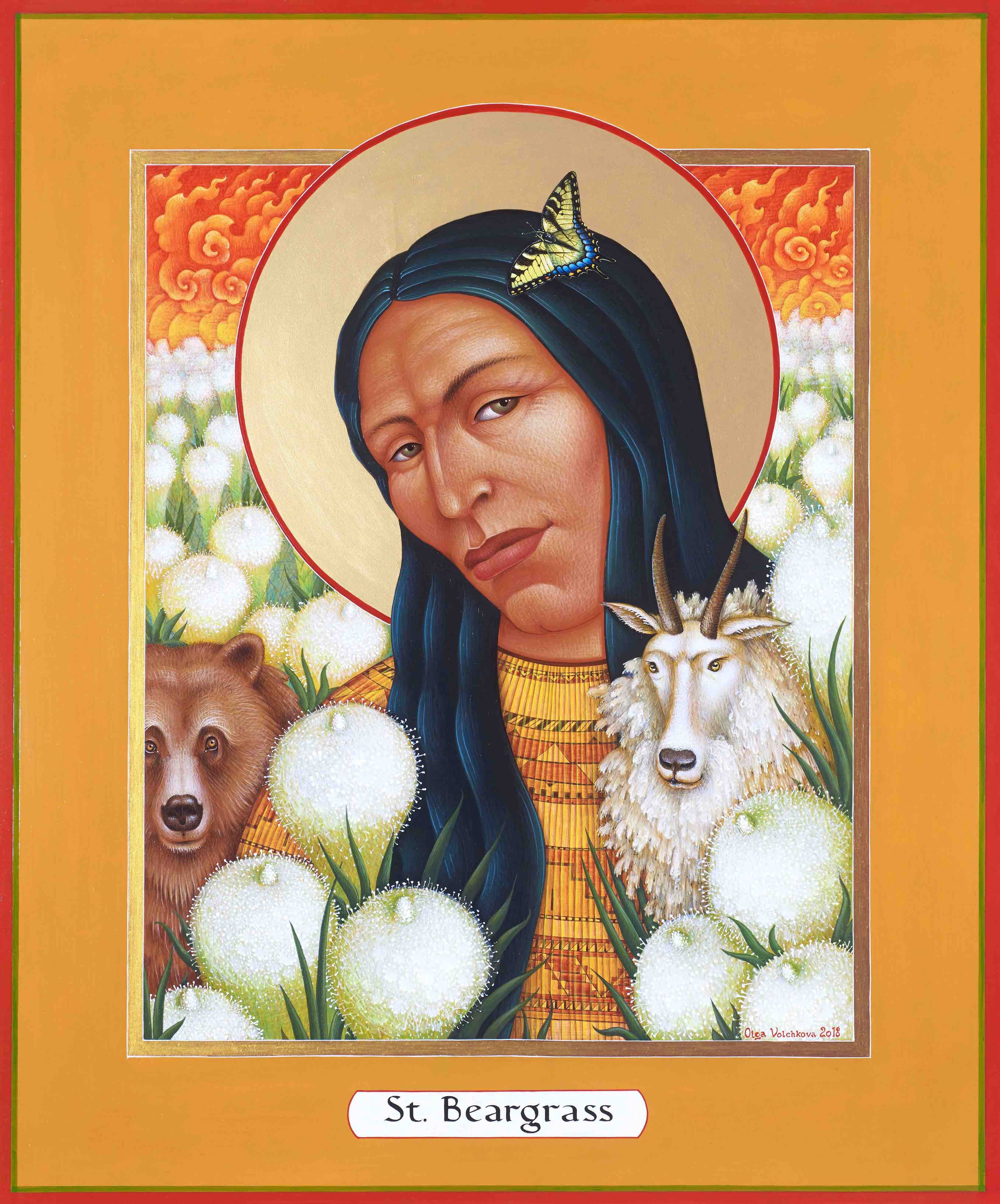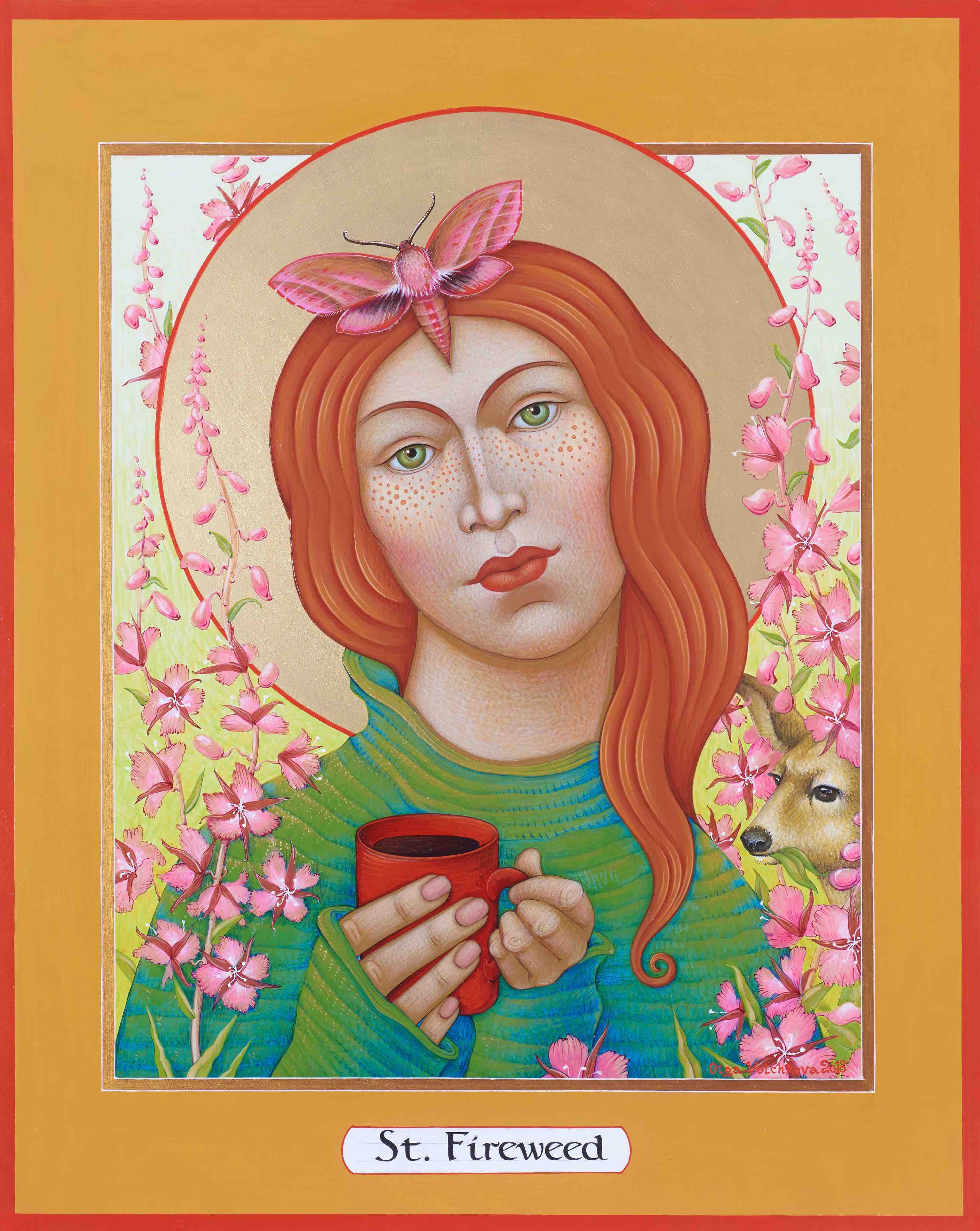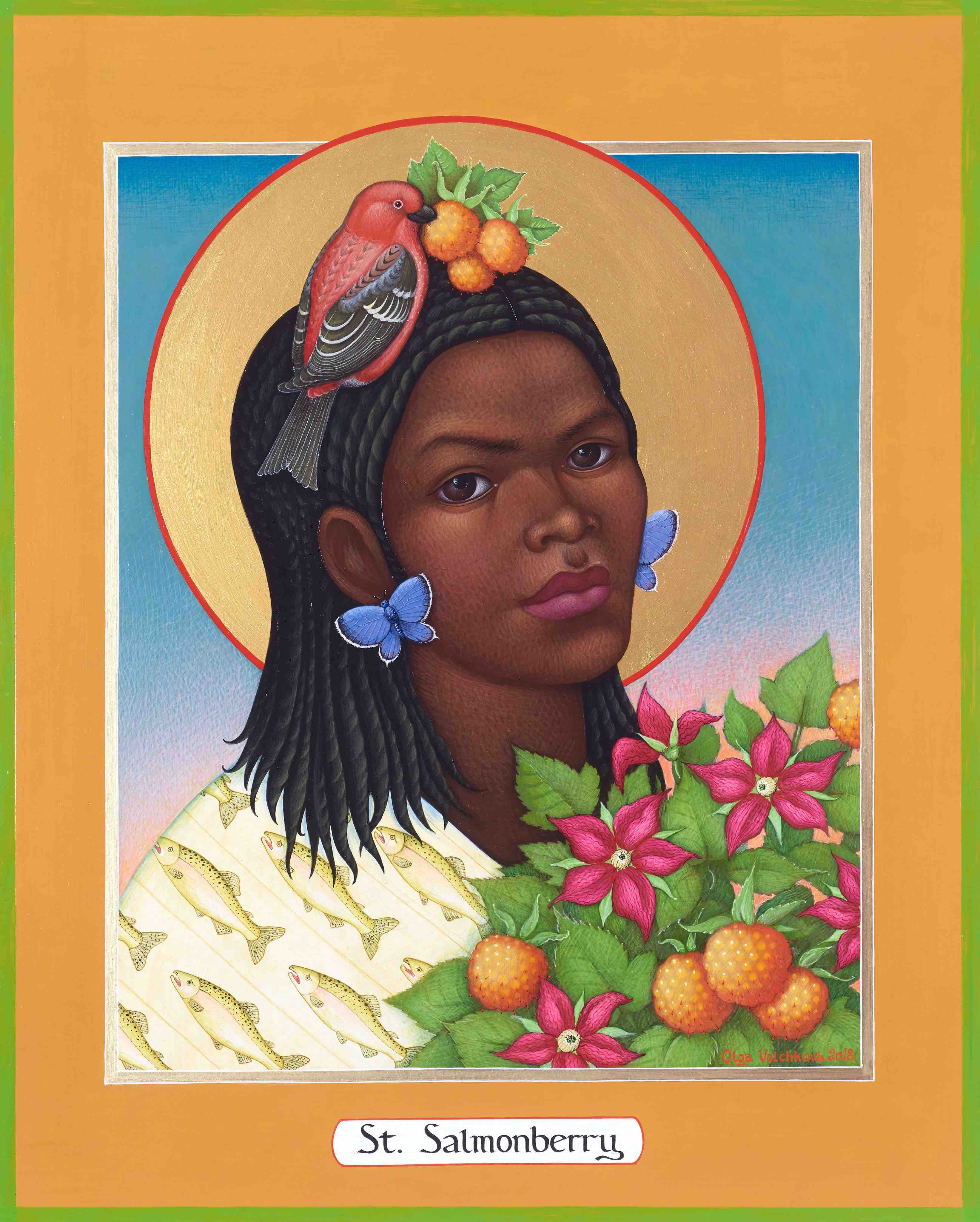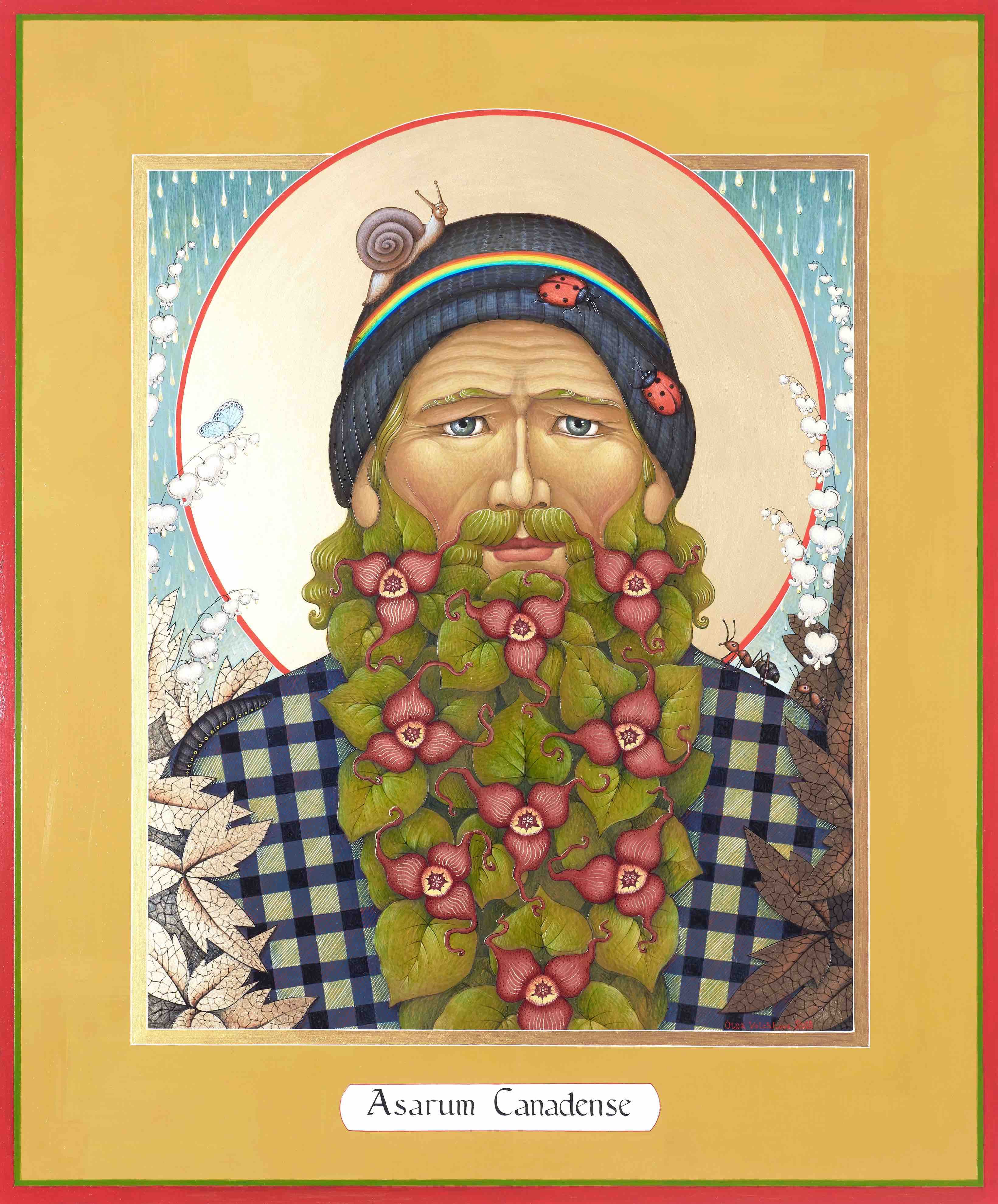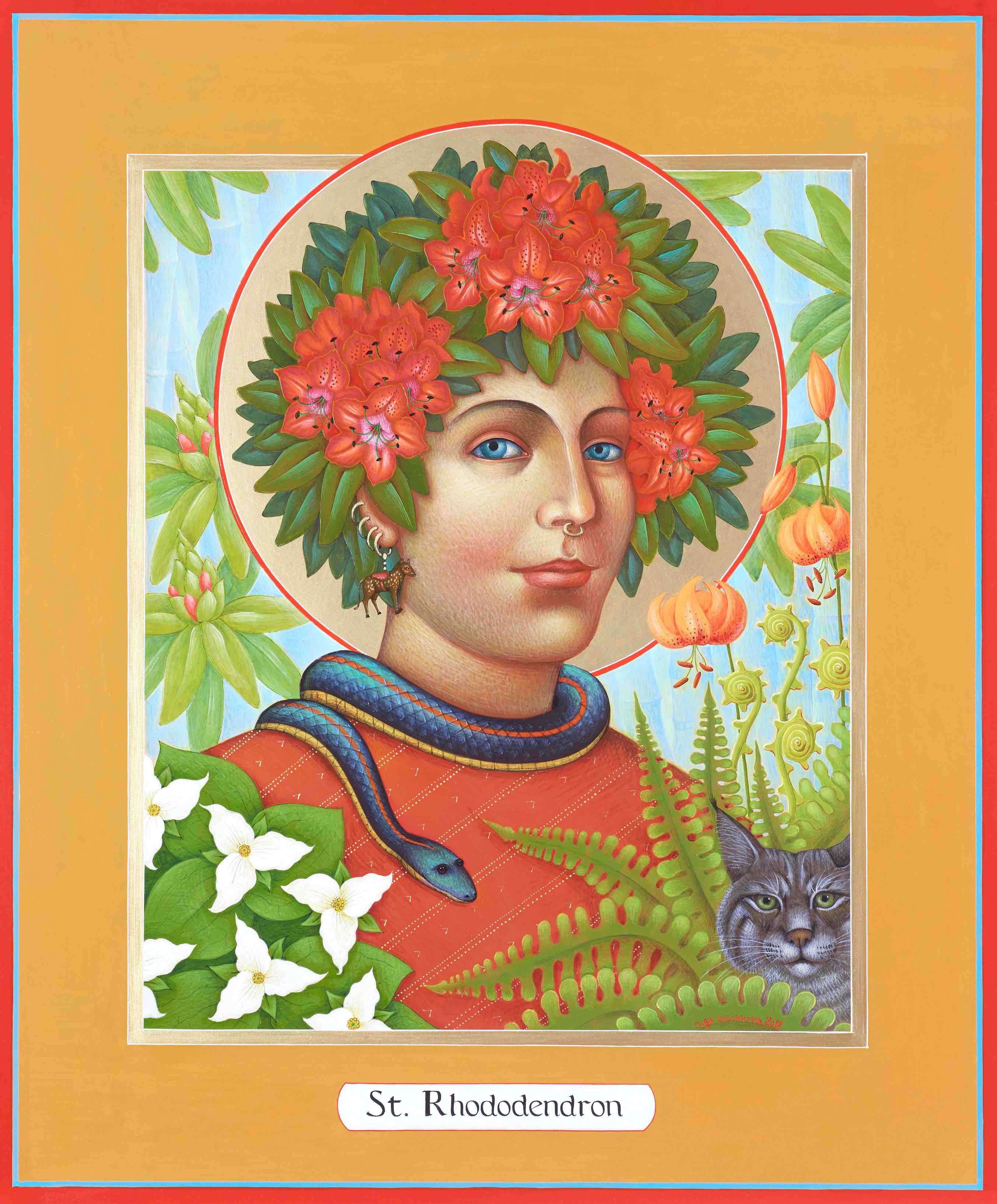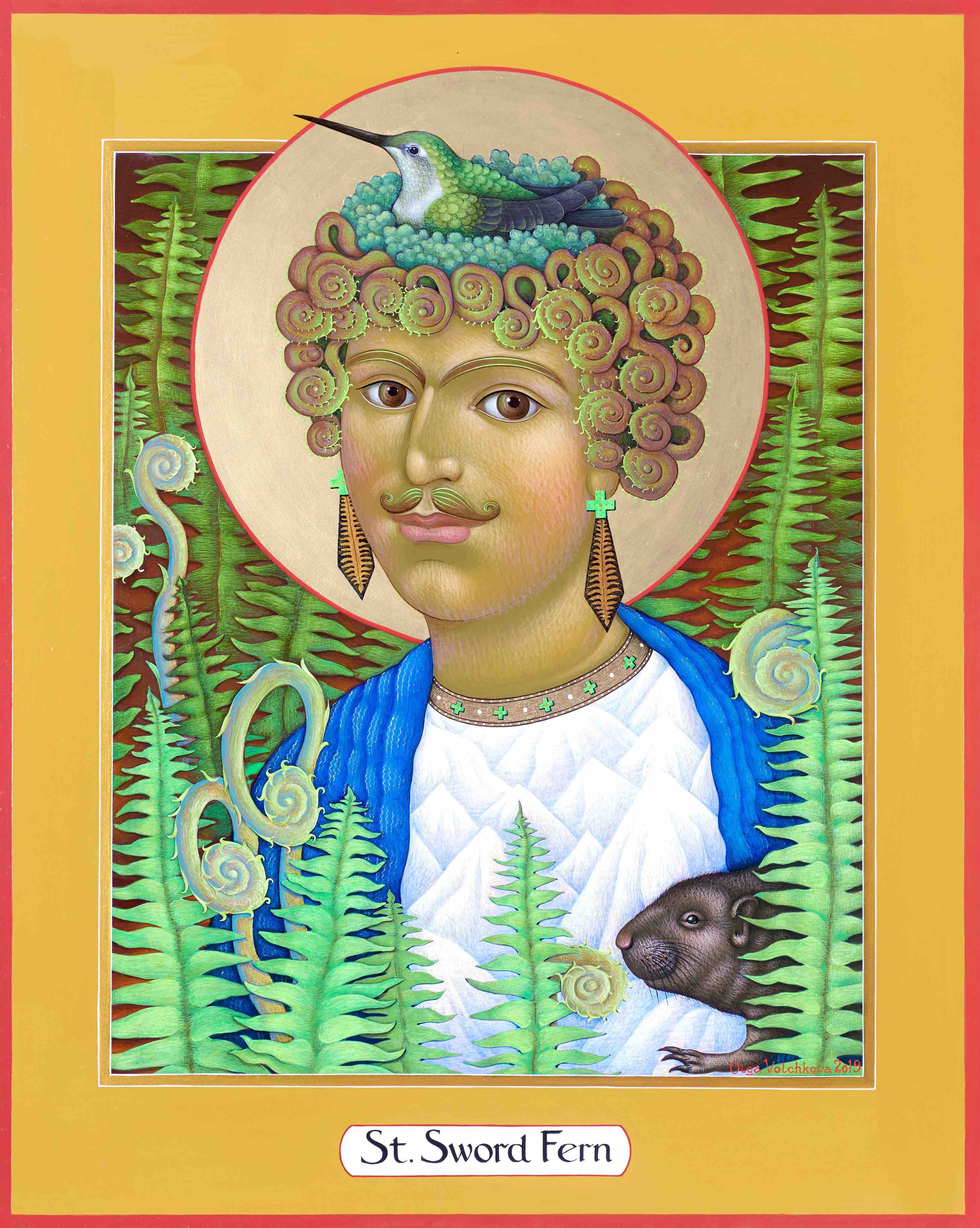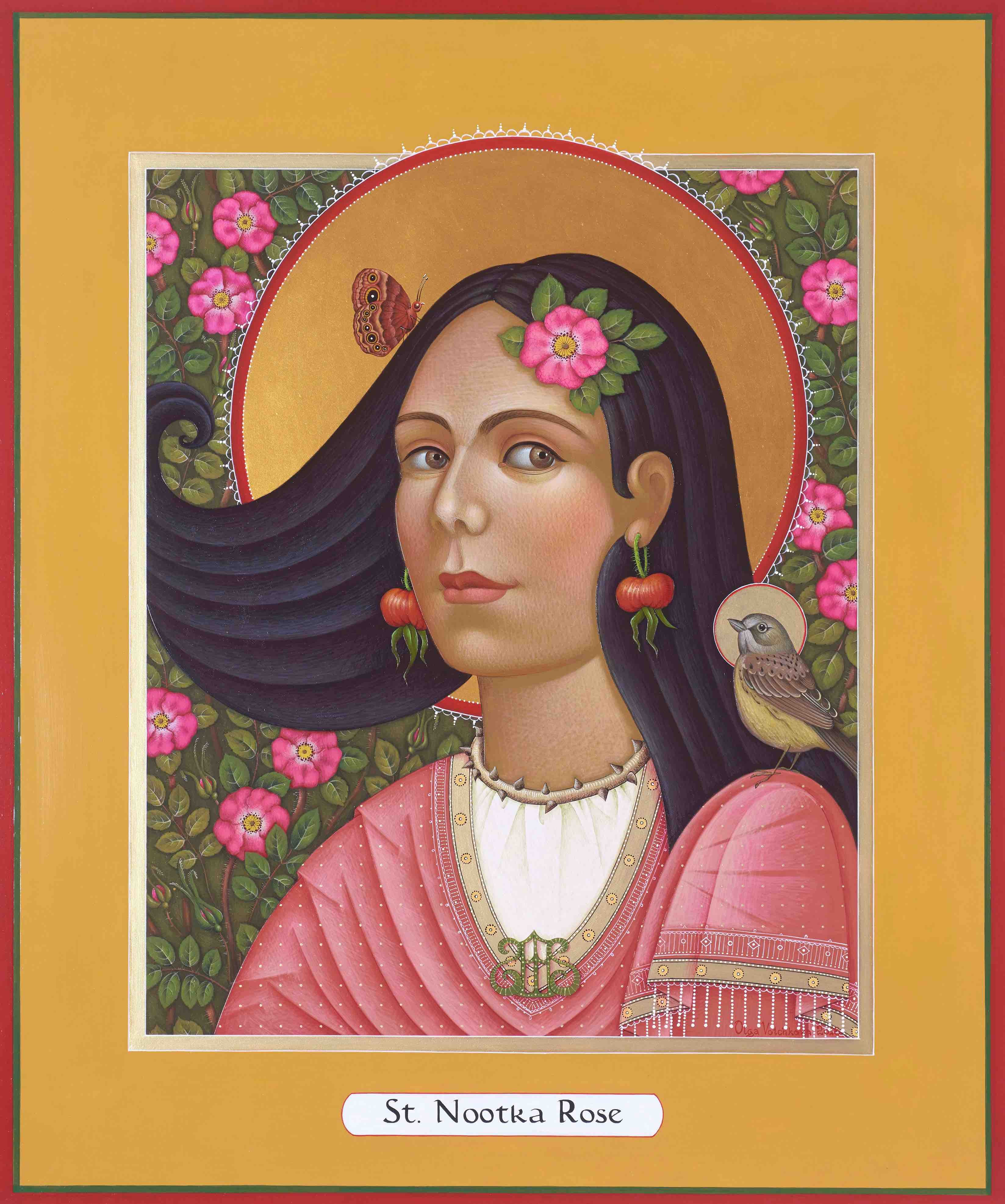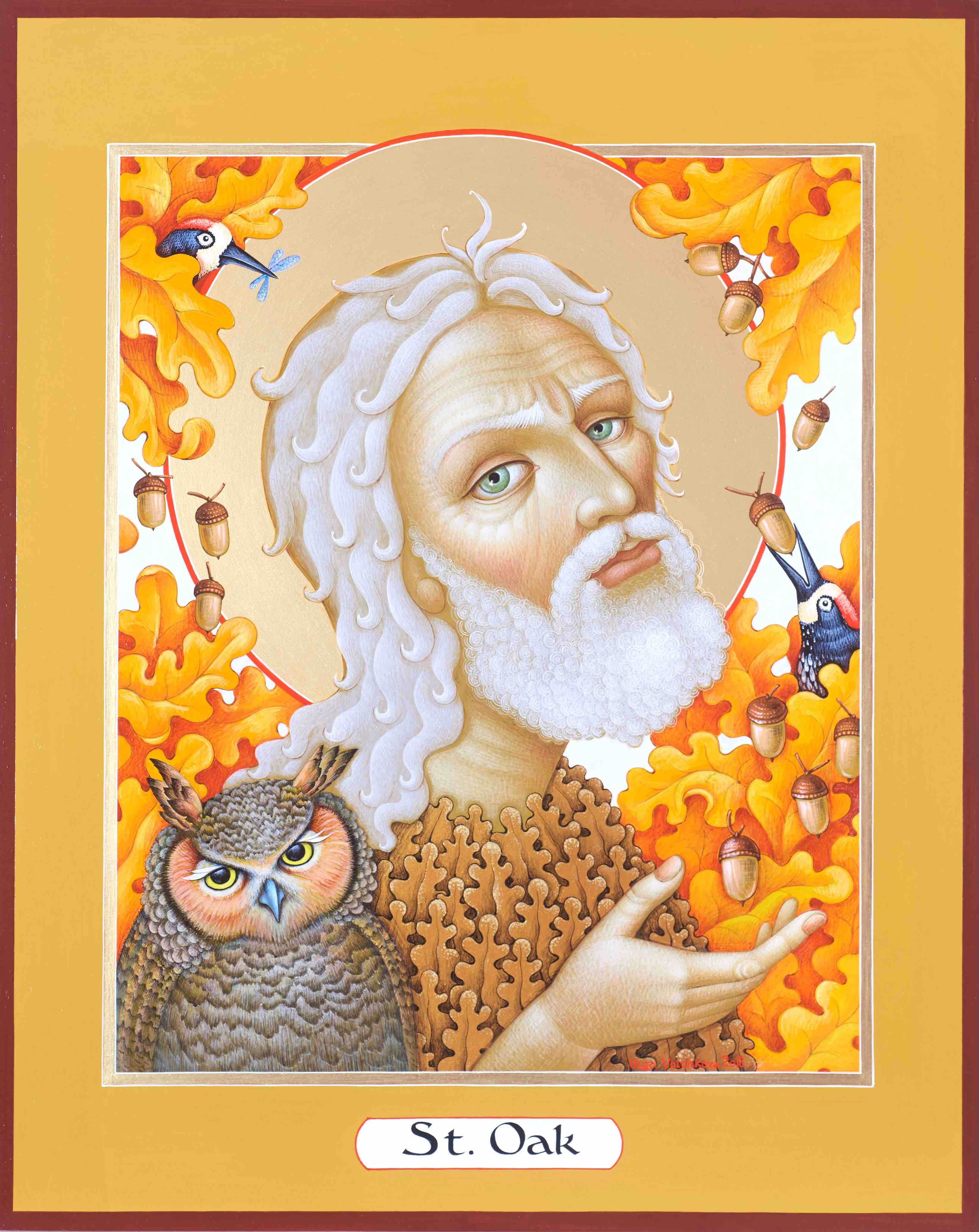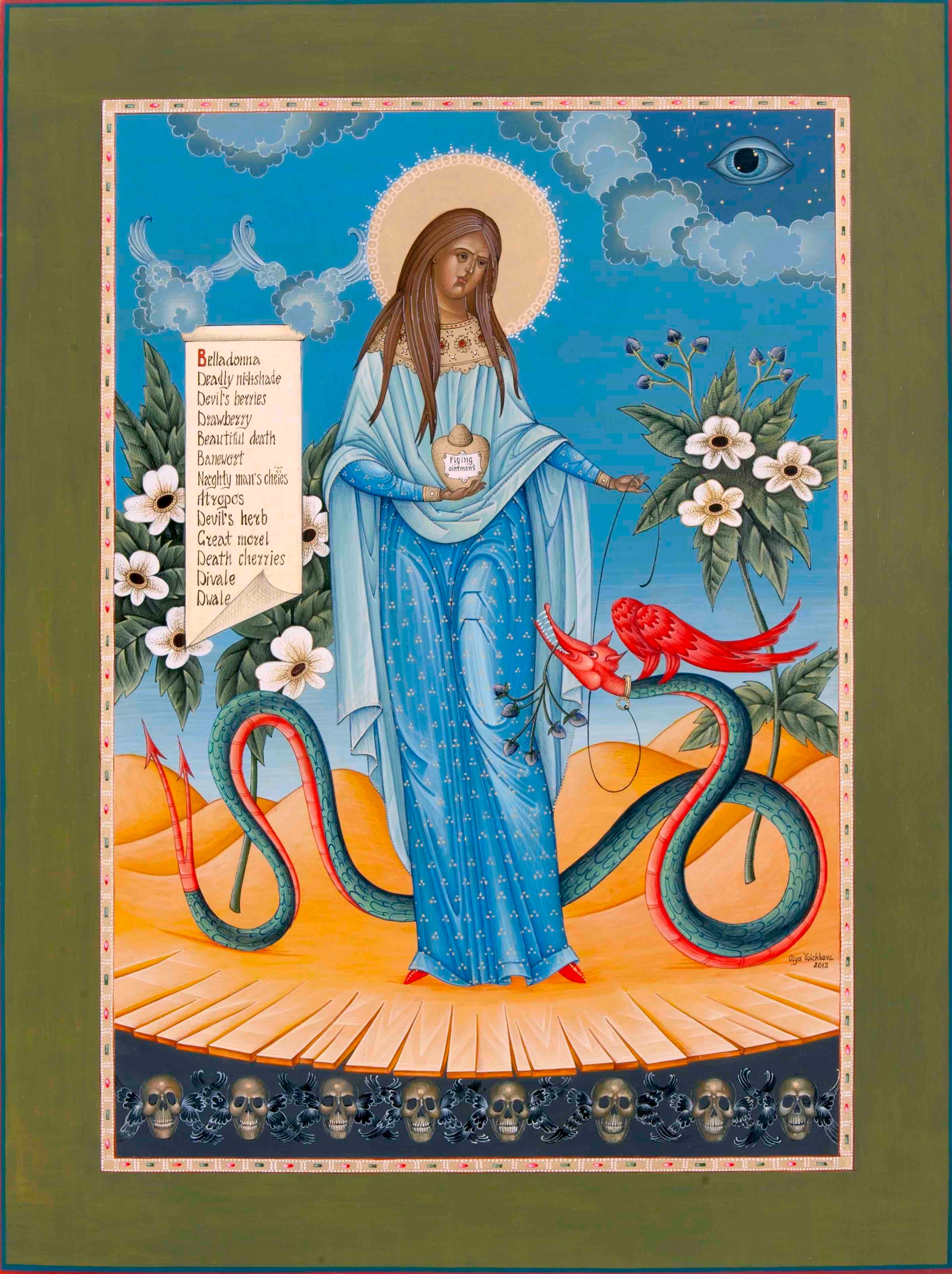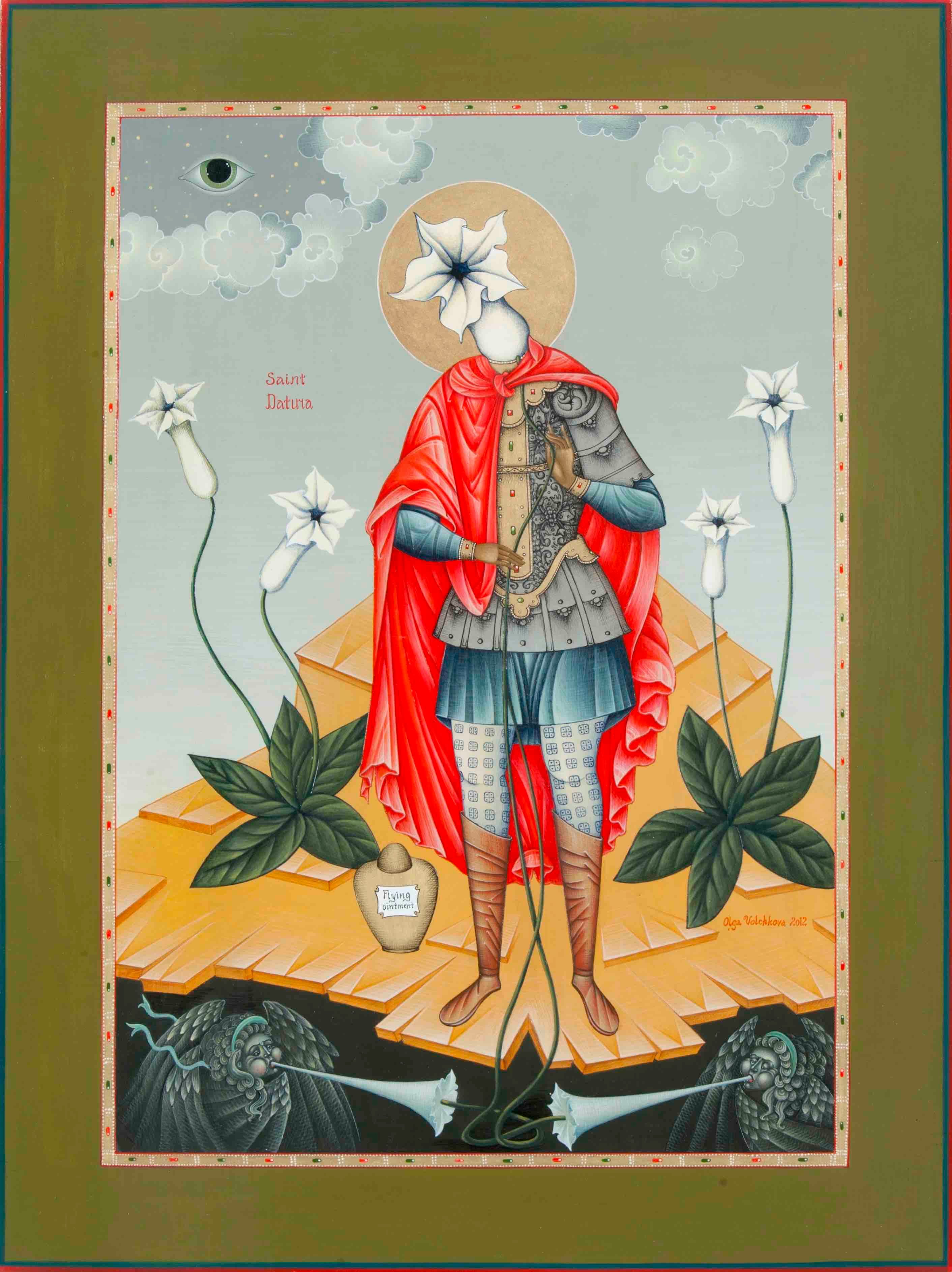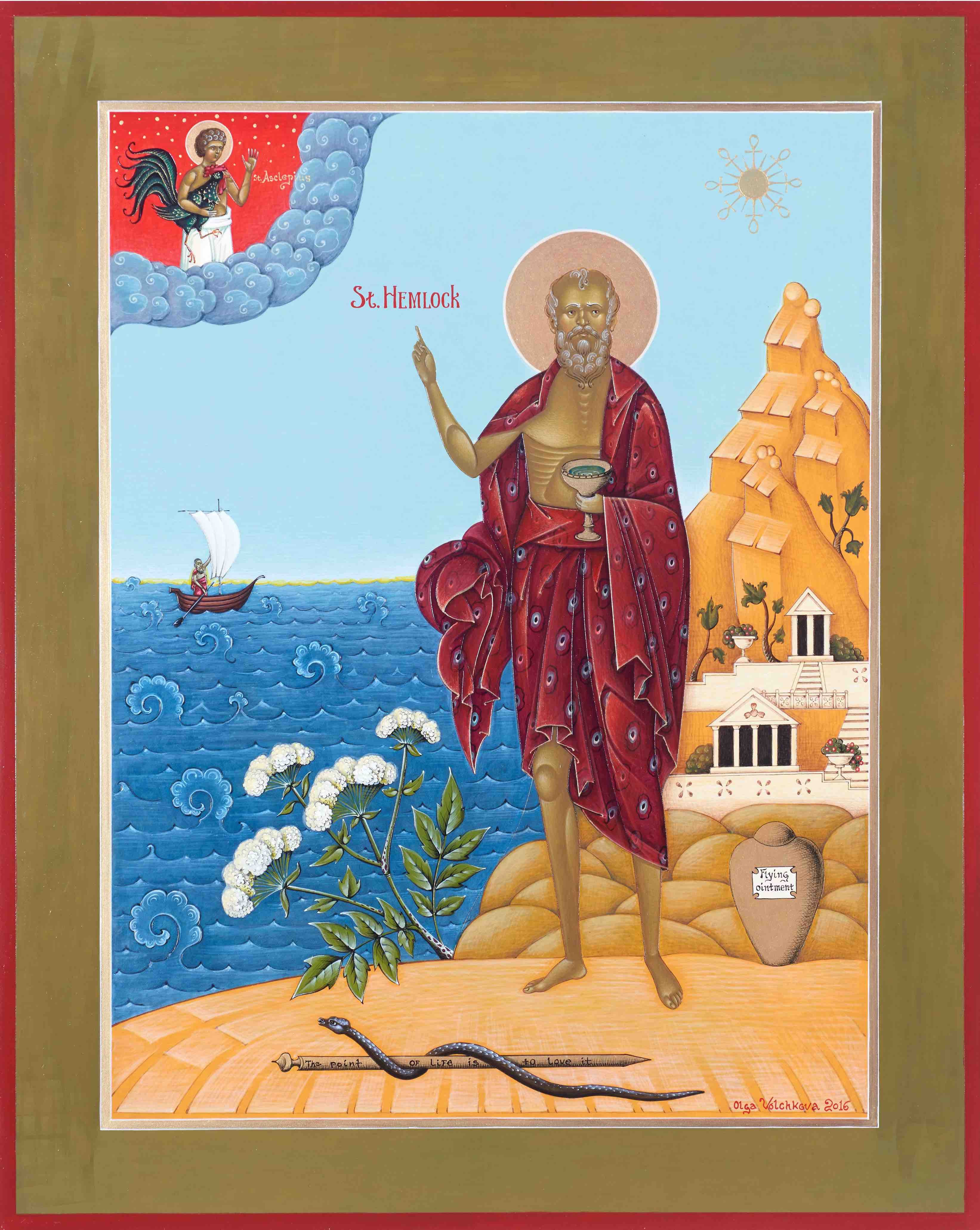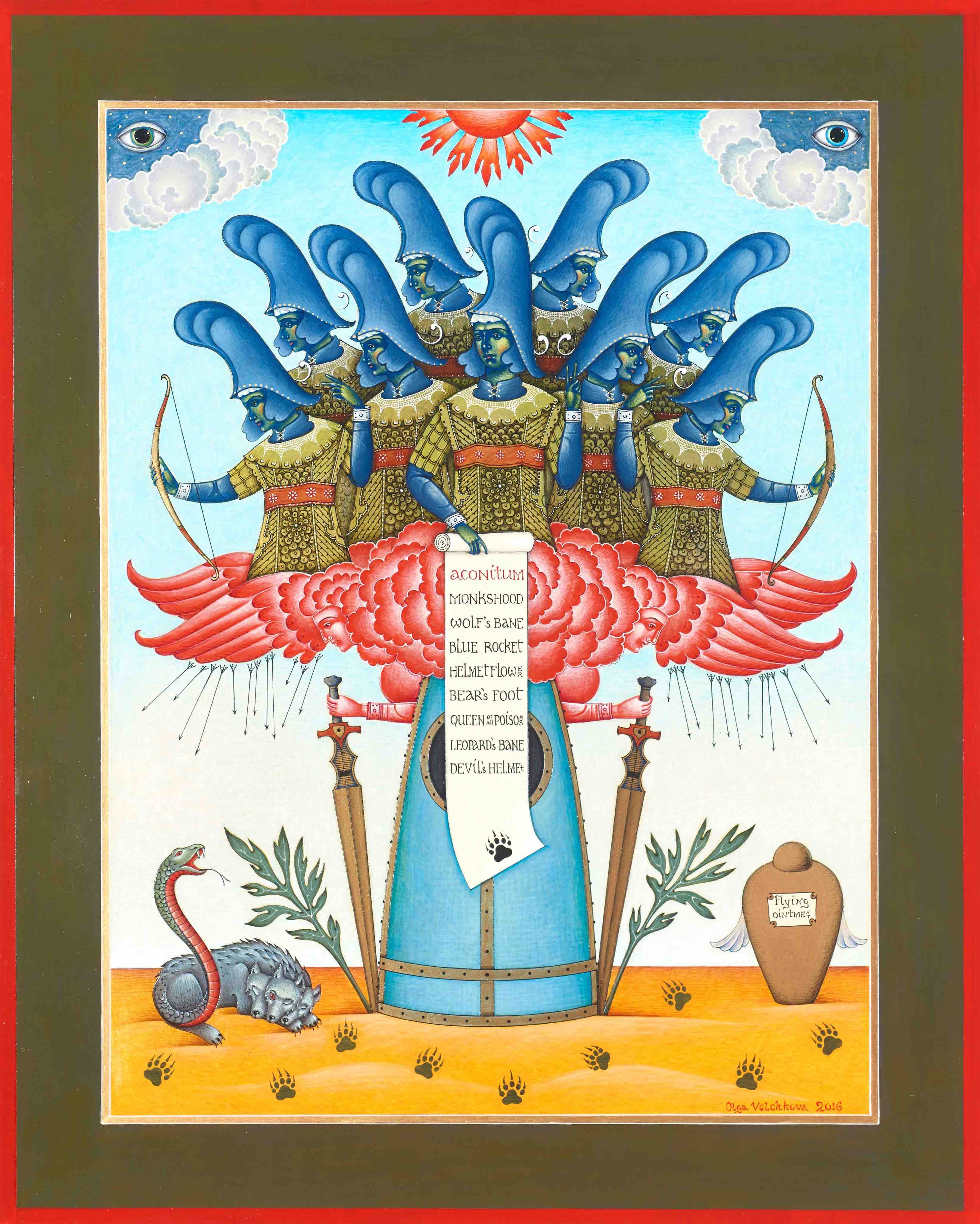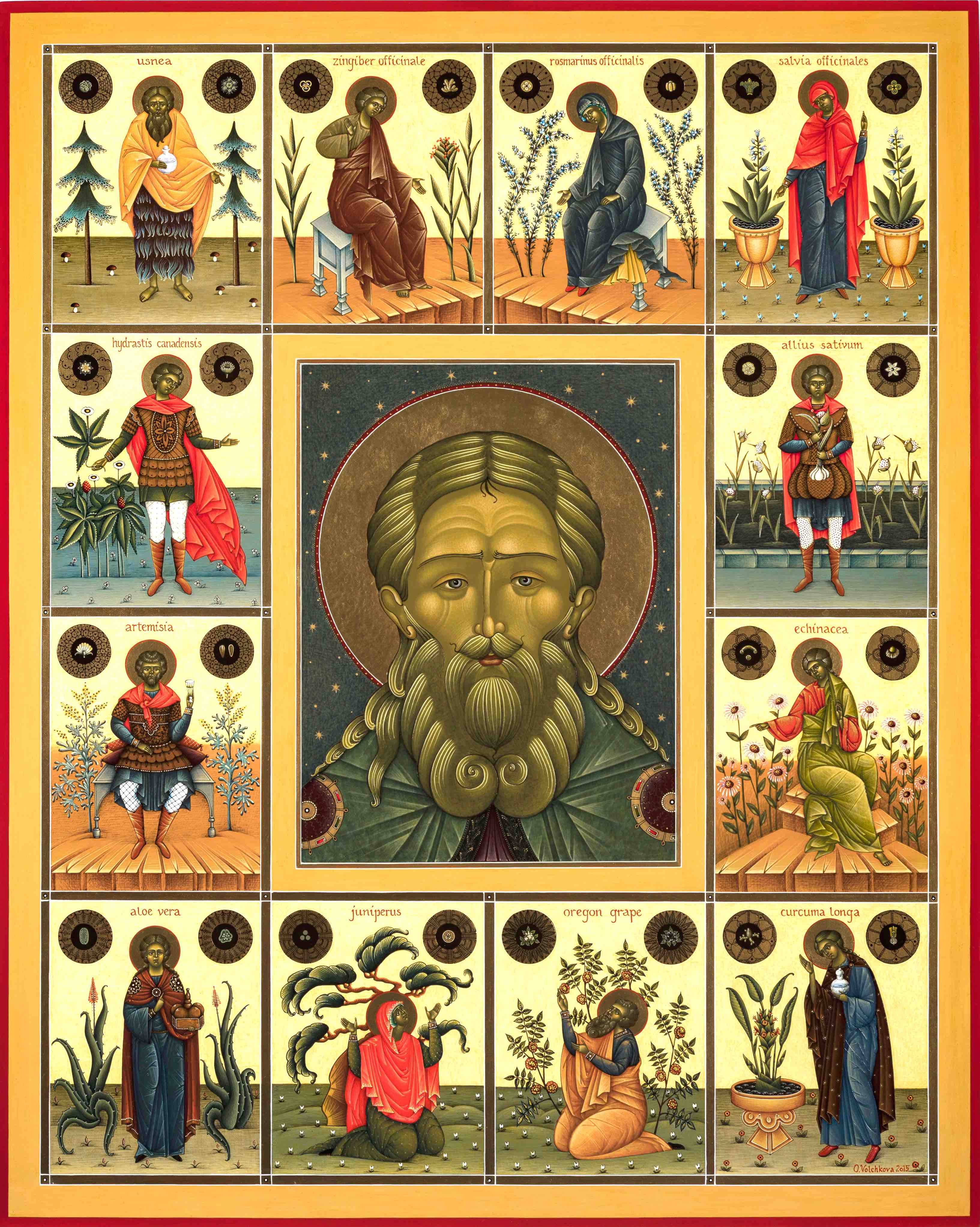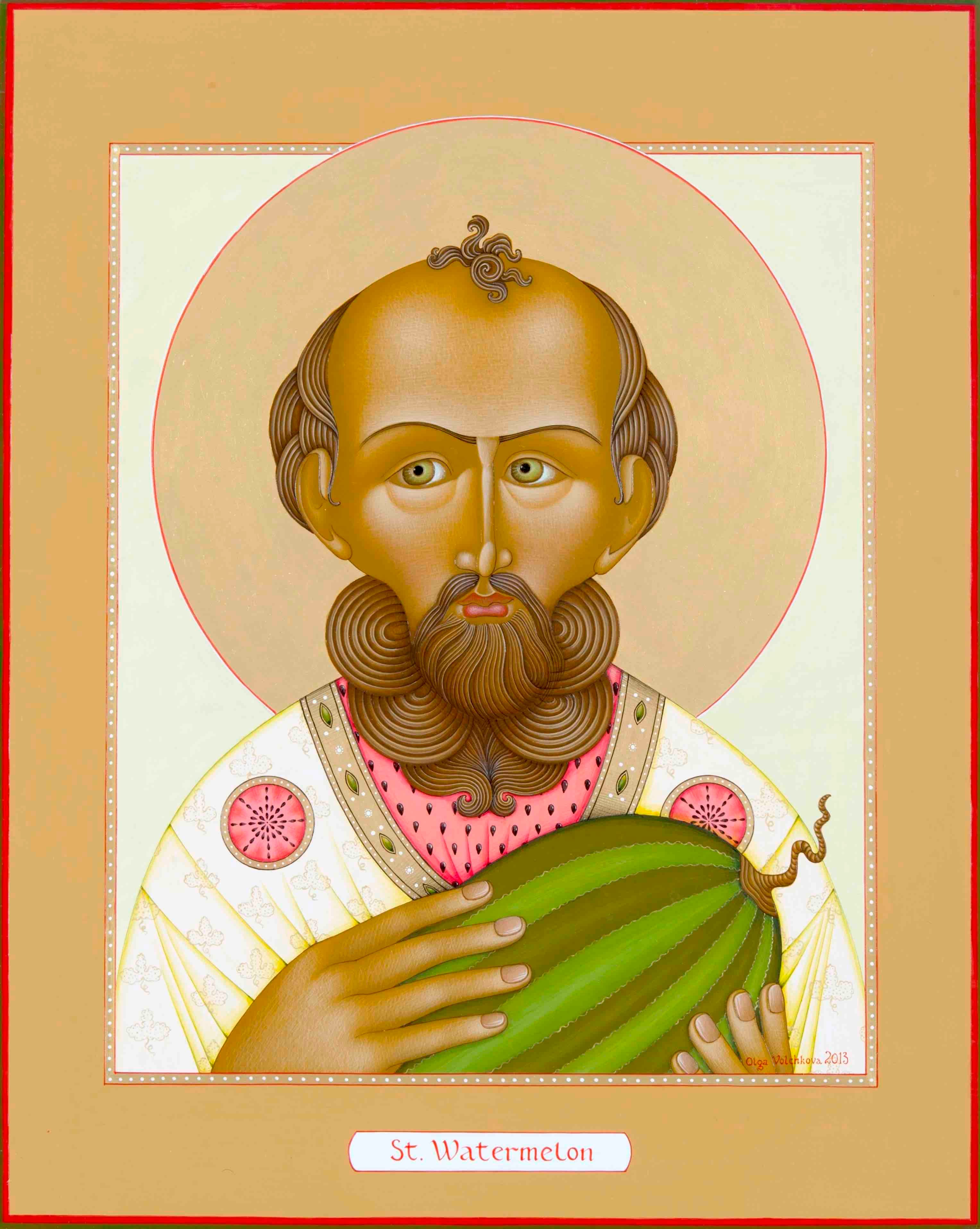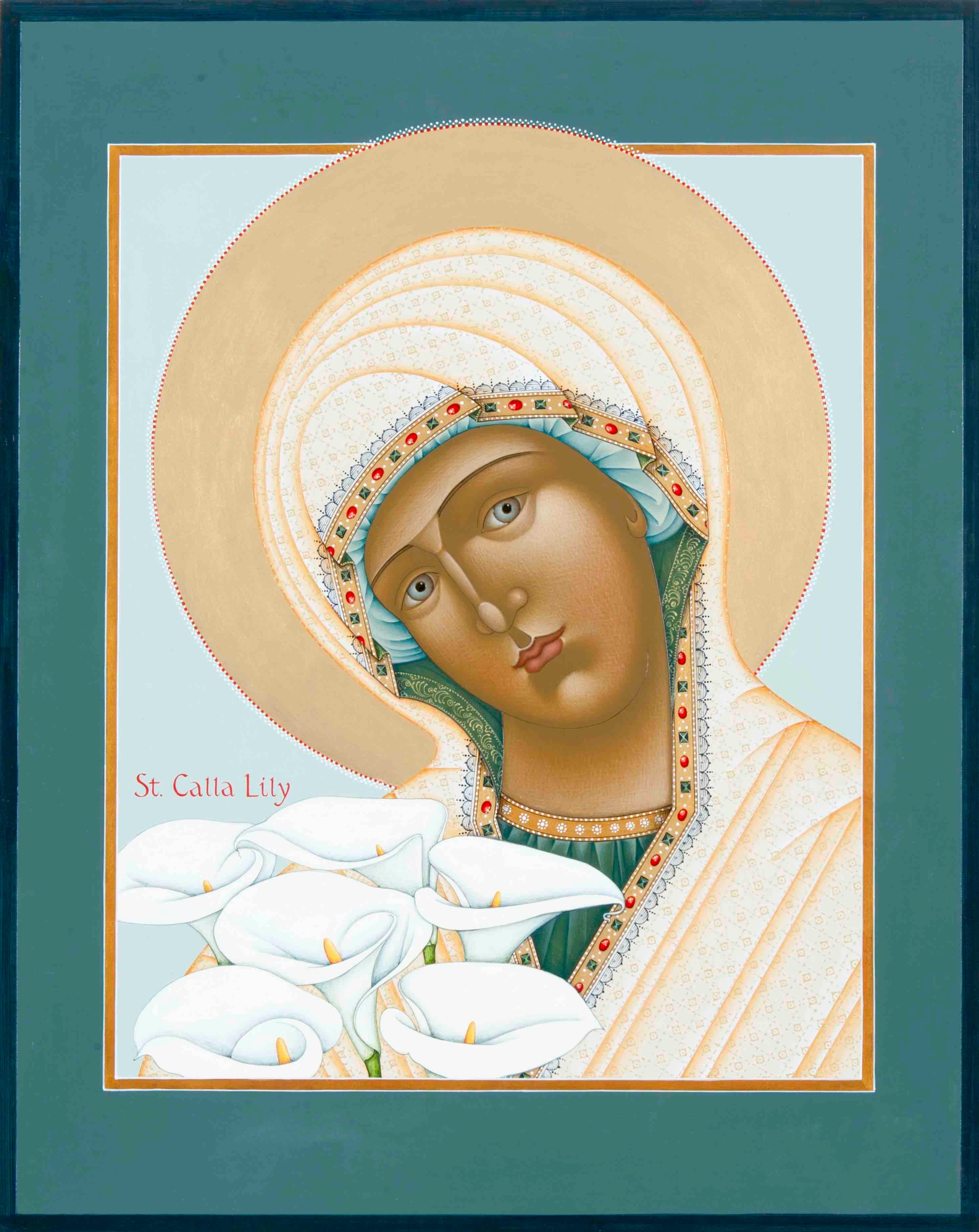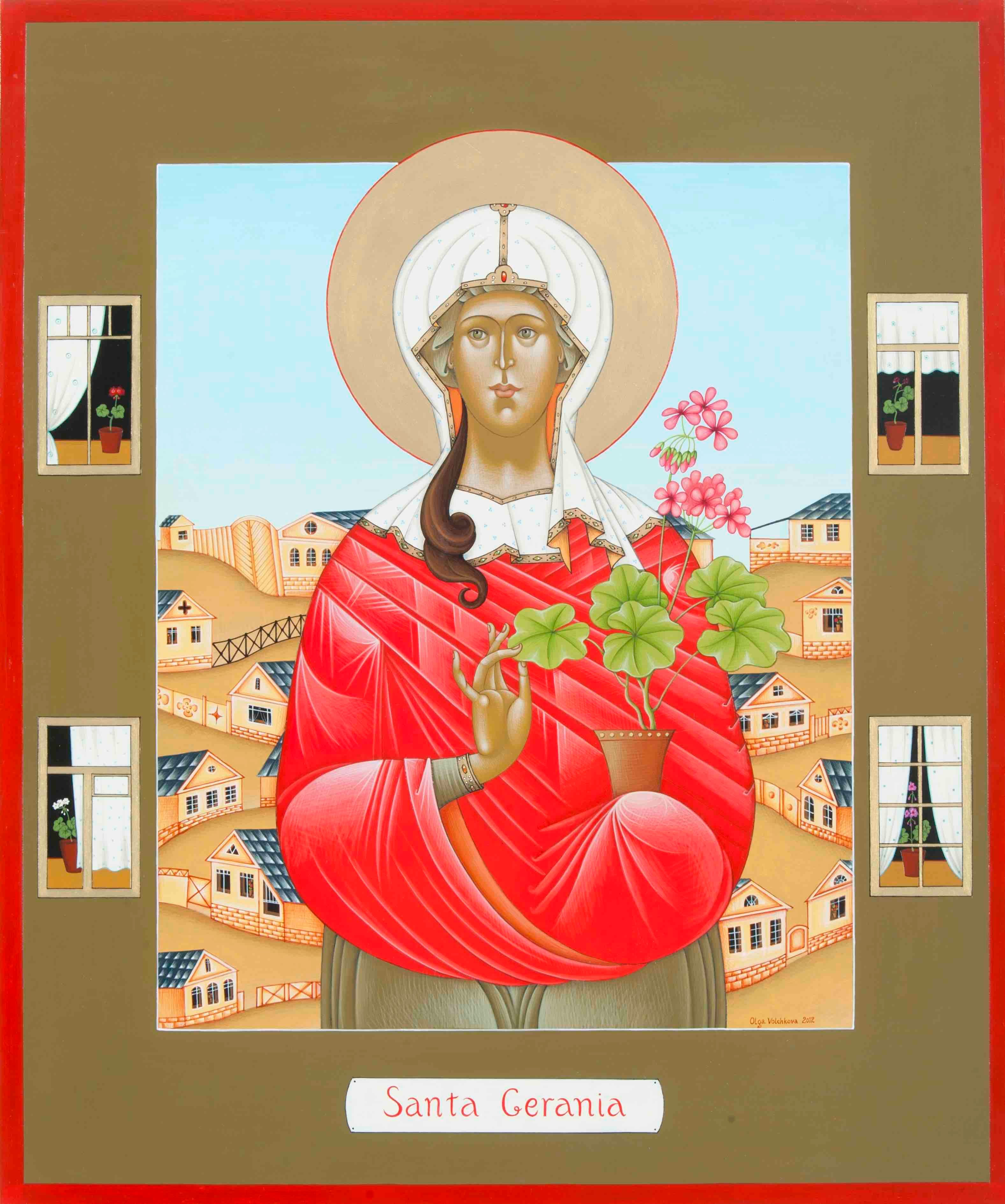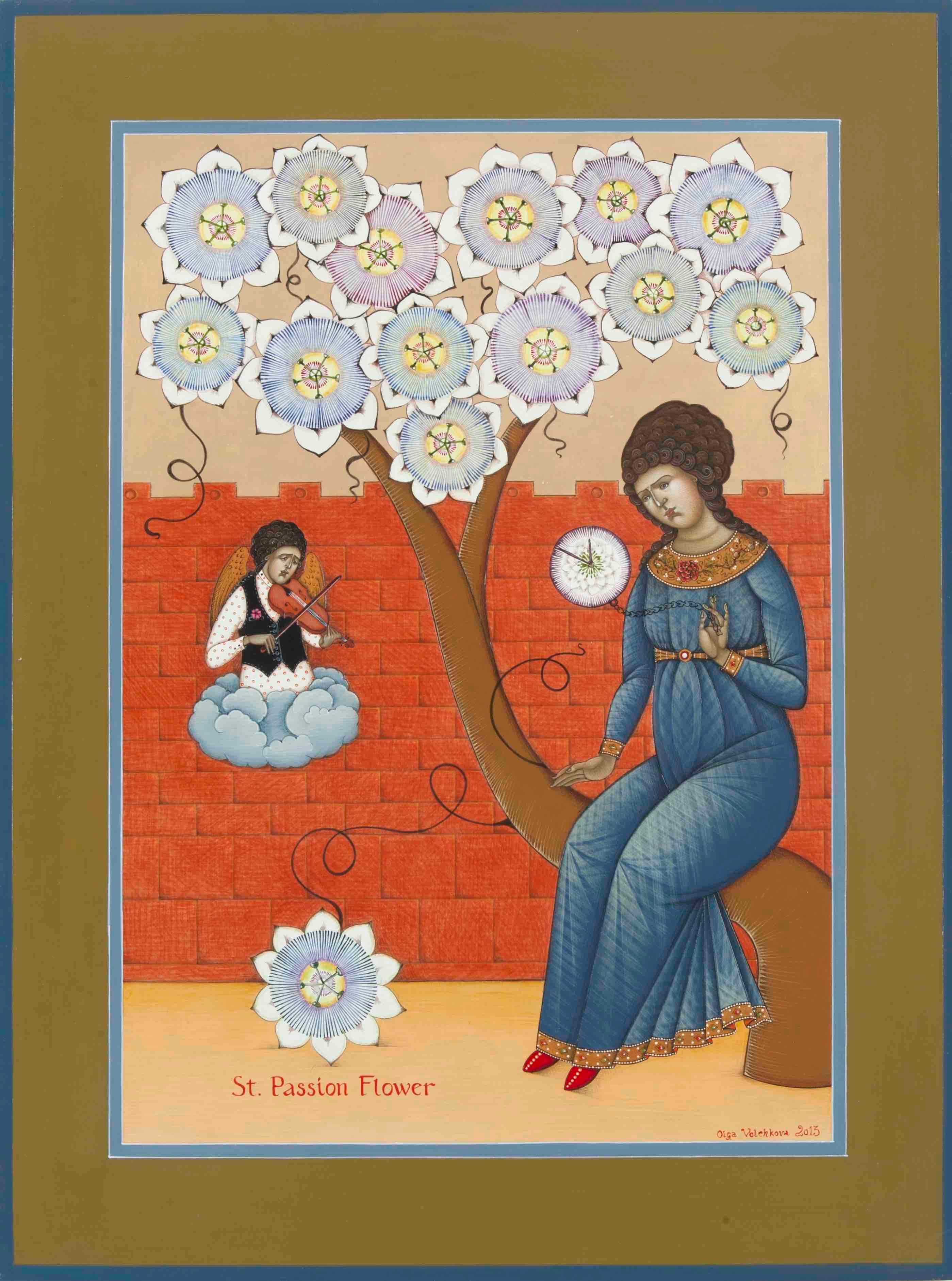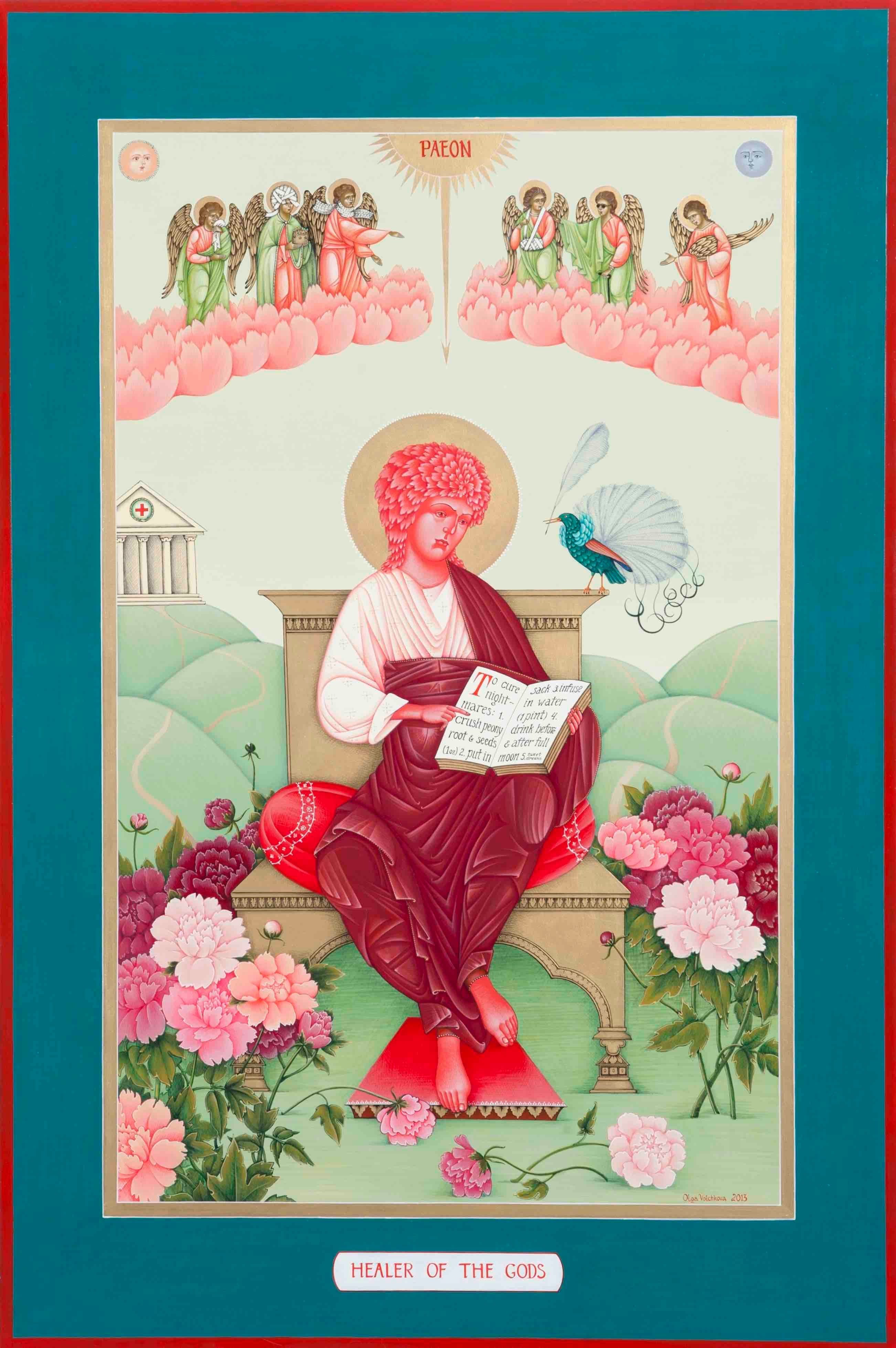Oregon Native Saints
Solo exhibit April 3 - June 1, 2019 Karin Clarke Gallery Eugene, Oregon "We need to respect nature. We need to understand ecosystems. These are the most important things we need to do, right now." -- Olga Volchkova Trained as an icon painter and conservator -- she was part of the first wave of new painters that revived iconography and painted new iconostases in churches after the collapse of the USSR -- artist Olga Volchkova uses her knowledge of orthodox iconography, along with her love of botany, and experience with subsistence farming, to create complex paintings that could be considered a secular extension of the icon tradition. They tell stories about the history and present deep importance of plants and their ecosystems, encouraging people to better understand the responsibilities of their supportive roles as participants in the diversity of the natural world. The Oregon Native Saints "St. Camas" 2018 20" x 24" wood & acrylic In the end of spring I walked around Mount Pisgah’s arboretum. Grasses were still lush, filled with moisture. The hot Oregon summer hadn’t started yet. Most of the spring flowers were already done with blooming. But bright blue stars were glowing inside of the green pastures, buzzing with young bees and insects. I see a beautiful blue crane, flying very very slowly, looking for the little shrews that love to eat camas bulbs. These bulbs were used for millennia by local natives, as a stable source of sugar and starch. "St. Aquilegia Formosa" 2018 20" x 24" wood & acrylic The brilliant orange-red blossoms of western columbine shine like little flames on the dark Oregon forest floor in spring. The flowers’ sugary nectar provides long-awaited and welcome food for hummingbirds. Columbine is also a primary habitat for pollinators, including bees and hawk moths. Aptly named, Aquilegia means “water collecting,” formosa means “beautiful,” and columbine means “like a dove.” Columbine is a widely used medicinal plant in European and Native American herbal traditions. "St. Beargrass" 2018 20" x 24" wood & acrylic In the early summer in eastern Oregon, where the altitude is higher and the landscapes are breathtaking, you can see this tall, gorgeous, floating, lace-like, club-shaped flower. The plant blooms once every five to ten years, so seeing many at once is miraculous and magical. Beargrass is one of the first plants that grows on land scorched by fire, which helps to bring the rest of the vegetation, fungus, and animals back after a fire, clearing dead and dying plant matter from the surface. Beargrass provides food for mountain goats, nesting material for bears, and excellent weaving material for baskets and clothing. The fibers are flexible and tough. "St. Fireweed" 2018 16" x 20" wood & acrylic In the midsummer, higher altitude pastures look like transparent pink seas of Fireweed’s candle-like flowers. They are called ‘fireweed’ because they’re one of the toughest plants that grow on scorched land, and they bring life back to that land. Not everyone knows that all parts of this plant are edible: young spring shoots are especially delicious. They can be eaten raw or steamed, just like asparagus shoots. Young fireweed leaves make a delicious, high in vitamin C tea. In Russia and most of the earth’s lands of the north, including Oregon, fireweed was what ‘tea’ meant before black tea was imported. Fireweed also provides habit for many insects, and food for birds and other animals. "St. Salmonberry" 2018 16" x 20" wood & acrylic Rubus spectabilis is edible, providing food in various stages for all creatures, with the same fruit structure as a raspberry. Made into jams, candy jelly or wine, they were an important food for indigenous people. Traditionally the berries were eaten with salmon, but they also look rather like salmon roe or caviar. Its beautiful magenta flower looks absolutely stunning. "St. Wild Ginger" 2018 20" x 24" wood & acrylic In early spring, the attractive dark red flowers of wild ginger appear on the Oregon forest floor. They look like advanced alien ships hiding from view behind heart-shaped foliage. Although not related to culinary ginger, the roots produce a scent that is similar. Fresh or dried roots of wild ginger were used as a ginger substitute in times past, but the plant is not normally used today for culinary purposes, as it can contain poisonous compounds. Wild ginger’s seeds attract ants, which carry the seeds to their underground homes where they eat the tasty outgrowths of the seeds and leave the seeds themselves to germinate. "St. Rhododendron" 2018 20" x 24" wood & acrylic The first time I saw a rhododendron in bloom I couldn’t believe that nature, the source of all beauty, could make something as incredibly beautiful as this. We have so many native rhododendrons here in Oregon, turning back time for every forest, towards our tropical past. Rhodies always transport me to these ancient times, when dinosaurs roamed and flew, on an earth undisturbed by modern development. When they bloom all kinds of life is blooming, snakes and bees are waking, fern fiddleheads are emerging, the ecologies buzz with the joy of new beginning. "St. Sword Fern" 2019 16" x 20" wood & acrylic Our high mountain sources of water are key to Oregon’s lush environment. One of the most stunning native plants, the Sword Fern glows a fluorescent green near the creeks and rivers and forests of Oregon. Young fiddleheads of the sword fern provide an early spring source of food for many animals, including the mountain beavers, when they just awake from their winter hibernation. Sword Ferns are a painkiller in the native traditional medical toolkit. And they are gender fluid: they can be self- fertilizing as hermaphrodites, and they can take either gender in the cross-fertilization process. "St. Nootka Rose" 2018 20" x 24" wood & acrylic When I sense the gentle sweet fragrance of the wild nootka rose floating in the forest underbrush, or along the edges of wetlands, I know that Oregon’s summer has truly begun. Incredibly tender and beautifully modest, simple roses, they’re also naturally hardy. They produce rose hips in the autumn that glow throughout the winter in the forest. If you live in a cold climate, instead of going to the drug store, you go outside, pick 3 - 4 rose hips a day, and they’ll be your vitamin C pills. All kinds of birds also make use of the seeds in the rose hips. And the rose provides gorgeous, unforgettable, fragrances, that have inspired many poets and musicians and artists through the centuries. "St. Oak" 2018 16" x 20" wood & acrylic The Oregon White Oak (Quercus garryana) is a keystone species in the ecology we call oak savanna: a jewel in Oregon’s natural heritage. The white oaks of the Oregon savanna provide acorns, young buds, and shelter for insects, birds, rodents, and deer, as well as leaves for fungus, mosses, soil invertebrates, and animals further up the food chain. Oak savanna is a highly endangered light-density forest-prairie habitat, native to the Pacific Northwest and the Cascadian bioregion. The habitat includes camas and fritillaria, major native food sources, and other species that thrived in the controlled-burn stewardship of indigenous peoples. Oaks also provide beauty in fall, and shade in summer. The older Oak trees are, the more carbon they need, and the more they remove from the atmosphere. They are doing their best to save us. The Saints of Flying Ointment "St. Belladonna" 2012 18" x 24" wood & acrylic Belladonna means “beautiful woman” in Italian. The plant contains atropine, an extremely potent medicine. Medieval ladies used to drop it into their eyes to make their pupils wider and more attractive. It is today used by eye doctors for the same purpose. In the wild it’s very dangerous. It takes only six berries of belladonna to kill a human being. That’s why saint belladonna is holding a dragon, keeping the effect of those berries on a leash. If you know your dragon, you can use these berries safely -- in Flying Ointment, for example. "St. Datura" 2012 18" x 24" wood & acrylic Poisonous if taken internally, Datura makes you vomit and puts you to sleep. Never try it. I believe if we all knew more of the properties of plants, we could help each other more. Datura was a powerful medicine traditionally, and it’s also studied today, for its analgesic and antiasthmatic qualities. "Saint Hemlock" 2016 16" x 20" wood & acrylic ‘We owe a rooster to asclepius’ said Socrates, before he took his last breath. In ancient Athens, the death sentence was self- executed through a potion of hemlock. But in my paintings, I often give my characters a chance to escape their history. That’s the role of the little boat. One of the deadliest of nightshades, hemlock shouldn’t even be touched in the wild. It was used in tiny amounts as a part of the recipe known as “flying ointment” -- not taken internally, but rubbed on the skin. This would create a sort of psychedelic effect, making you feel like you’re flying. "Saint Monkshood" 2016 16" x 20" wood & acrylic In the very late autumn, when almost all colors are gone, when yellows and reds are dominating, and almost all perennials have finished blooming, these striking, spikey, tall blue flowers appear. Each individual flower looks like the helmet of a soldier, or the hood of a monk. Monkshood is very poisonous and should not be touched. According to legend, it grows from the place where cerberus (a dog with three-heads, and a tail like a snake) spit when he was brought from hades, angry and blinded by sunlight. I painted soldiers launching their arrowheads tipped with monkshood as poison -- from atop their blue rocket, which is another name for the plant -- used by hunters for centuries across many cultures. Sacred Herbals "Holy Spirit of Herbs" 2015 30" x 24" wood & acrylic Twelve figures representing natural antibiotics form the Holy Spirit of Herbs. The painting is in the “festival icon” format, used for a unifying theme, where twelve smaller compositions frame the central figure. Clockwise from the upper left, the saints along the edges of the work represent lichen, ginger, rosemary, sage, garlic, echinacea, turmeric, Oregon grape, juniper, aloe vera, wormwood, and goldenseal. "Saint Cannabis" 2016 24" x 30" wood & acrylic This magnificent plant came to us from the Indian subcontinent, with a potent history of traditional medicinal, spiritual, and recreational use. It was also widely used across the world for making fabric, paper, sails, robes, and ‘canvas’ (the word comes from ‘cannabis’). If you find your own personal key, and then find your personal portal, connecting you with this plant, both of you can have a nice adventure together. Choose wisely. Garden Saints "Saint Watermelon" 2013 16" x 20" wood & acrylic The watermelon, or Citrullus lanatus, is thought to have originated in the Kalahari Desert, in present-day Namibia. The first recorded harvest took place in Egypt some 5,000 years ago and is recorded in ancient Egyptian hieroglyphics. Watermelons, which are in the same family as cucumbers, pumpkins, and squash, were coveted by other ancient empires in Europe and Asia for their refreshing flesh. Here, notice the colors of the watermelon—the white of the pith, the pink of the mesocarp, and the black of the seeds—in the figure’s robes, while the shades of green in his eyes echo the stripes of green in the melon he grasps. From genetic evidence, we know that when watermelon first appeared, it was so popular that it moved unusually quickly across the continent. "Saint Calla Lily" 2013 16" x 20" wood & acrylic Zantedeschia aethiopica is a marsh plant imported to the US from South Africa in the mid-19th century. The exotic flowers became immensely popular in the art world of the early 20th century as Imogen Cunningham, Georgia O’Keeffe, Diego Rivera, and Edward Weston provocatively represented them in their photographs and paintings. Despite the many sensual interpretations of the calla lily’s form in modern art, the flower has also been associated with purity. "Saint Gerania" 2012 20" x 24" wood & acrylic The name for the genus of flowers to which the geranium belongs originated from the Greek word for crane, which is géranos, because of the fruit capsule’s resemblance to a crane's bill. Geranium plants have grown wild in Europe for thousands of years and have been cultivated there to be used in herbal remedies since the medieval period. The plant boasts properties that stop bleeding and tighten tissues, and is often used externally to treat minor wounds. As they are hearty plants that can survive harsh winters, they are also used decoratively in cold climates, such as Russia. These flowers provide hope during the winter months in even the most humble of homes. "Saint Passion Flower" 2013 18" x 24" wood & acrylic The passiflora vine would tempt any storyteller: an elegant clockface flower, an indelible fragrance, and the exotic passion fruit. A native of the americas, with evidence of human use for thousands of years, it played countless roles in natural and cultural history. As an example: the flower reminded Spanish missionaries of Christ’s crown of thorns in the Passion, so they built an extended theological symbolism for the plant, for didactic purposes. The plants is also known as c’um bat’z, parcha, maypop, merecoya, maracujá, chinola, granadilla, and ocoee. It was certainly, regretfully, the subject of many tales we have lost. "Paeon" 2013 24"x 36" wood & acrylic The peony already has a long history in human spiritual life. Many gods and demigods associated with the Greek pantheon were involved in healing and medicine. One of these, Paeon, is known as the healer of the Olympian gods. In verses 401 and 899 of Homer’s Iliad, Paeon applies soothing herbal ointments to heal first Hades and then Ares. In this work, the healer’s many patients float in the floral clouds at the top of the painting. The titular character is seated on a throne nestled among the flowers named for him. In his hands, he holds a book enumerating some of the flower’s medical applications. |
|
|


